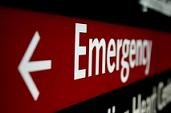Advertisment
Crowded emergency departments deliver less effective pain relief

First study of its kind to focus on children. Crowding in hospital emergency departments has led to a decrease in the timely and effective use of pain medication in children suffering acute long bone fractures, according to a new study by the University of Colorado School of Medicine.
“Pain associated with long bone fractures can be pretty severe,” said Marion Sills, MD, MPH, the lead author of the study. “But crowded emergency departments are impacting the delivery of care on many levels, including the delivery of pain medication.”
Sills and her colleagues focused on long bone fractures – broken arms and legs – because they are common among children and very painful.
The study was published this month in the journal Academic Emergency Medicine.
Sills, associate professor of pediatrics at the CU School of Medicine, studied 1,229 patients treated in the emergency department of an academic children’s hospital over a year-long period.
She found that patients were 4 to 47 percent less likely to receive timely care and 3 to 17 percent less likely to receive effective care when crowding was at the 90th rather than the 10th percentile.
Five previous studies have shown that crowded emergency rooms lead to lower levels of pain control among adult patients. But this was the first time researchers investigated the impact of crowding on children with fracture-related pain.
“We found that crowding can lower the likelihood of timely treatment by as much as 47 percent and raise the likelihood of non-treatment by as much as 17 percent,” Sills said. “The relationship between emergency department crowding and pain treatment is not unexpected. When the emergency department gets busier, staff may be less responsive to the needs of individual patients, and as a result, patients have a higher likelihood of non-treatment and delays in treatment.”
Although not studied in this article, Sills speculates that the reasons for this are varied. In some emergency departments, for example, only doctors can authorize the use of potent opioids for pain, whereas in other settings, hospital policy permits nurses to administer analgesia to patients meeting specific criteria.
“The expensive way to mitigate crowding is to hire more staff. Another way is to leverage the staff you have,” Sills said. “Institutions can use techniques like protocols for pain management with standing orders for nurses, and computer- or phone-based alerts to call attention to under-treated pain.”
Another idea, Sills said, is to create incentives for patients to seek care at their own doctor’s office, including better compensation for primary care and disincentives for non-emergency use of emergency departments.
Sills has studied hospital crowding for years. She recently published a paper showing that children’s hospitals nationwide were underequipped to handle a major pandemic due to a shortage of beds.
“Crowding is a serious issue for everyone. It is caused by a variety of things, from patients who too readily use emergency departments to federal policies that exacerbate the problem,” Sills said. “We as a nation need to get serious about this. Crowding needs to be a policy priority at every level.”
The study was funded by the Emergency Medicine Foundation, the Agency for Healthcare Research and Quality and The Children’s Hospital Research Institute.
Faculty at the University of Colorado School of Medicine work to advance science and improve care. These faculty members include physicians, educators and scientists at University of Colorado Hospital, The Children’s Hospital Colorado, Denver Health, National Jewish Health, and the Denver Veterans Affairs Medical Center. Degrees offered by the UC Denver School of Medicine include doctor of medicine, doctor of physical therapy, and masters of physician assistant studies. The School is located on the University of Colorado’s Anschutz Medical Campus, one of four campuses in the University of Colorado system.
Contact: David Kelly david.kelly@ucdenver.edu





